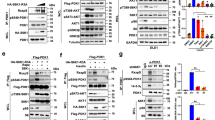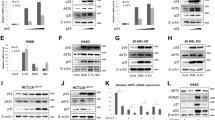Abstract
Upon exposure to genotoxic stress, the c-Abl tyrosine kinase is released from cytoplasmic 14-3-3 proteins and then is targeted to the nucleus. Phosphorylation of Thr735 in c-Abl is critical for binding to 14-3-3; however, kinases responsible for this phosphorylation are unknown. Here, we identify CLK1, CLK4, MST1, MST2 and TTK (also known as Mps1) as novel Thr735 kinases in vitro by expression cloning strategy using phosphospecific antibody. We also demonstrate that ectopic expression of these kinases is capable for phosphorylation of Thr735 in cells. Importantly, upon exposure to oxidative stress, phosphorylation of Thr735 is transiently upregulated, and the status of this phosphorylation remains unchanged in cells silenced for CLK1, CLK4, MST1 or MST2. By contrast, knockdown of TTK attenuates phosphorylation of Thr735, suggesting that TTK is a physiological kinase that phosphorylates Thr735. In concert with these results, we show that, in cells silenced for TTK, c-Abl is accumulated in the nucleus even in unstressed condition and no further targeting into the nucleus occurs after oxidative stress. Moreover, nuclear entrapment of c-Abl by knocking down TTK enhances oxidative stress-induced apoptosis. These findings provide evidence that TTK phosphorylates c-Abl at Thr735 and that this phosphorylation is of importance to the cytoplasmic sequestration of c-Abl.
This is a preview of subscription content, access via your institution
Access options
Subscribe to this journal
Receive 50 print issues and online access
$259.00 per year
only $5.18 per issue
Buy this article
- Purchase on Springer Link
- Instant access to full article PDF
Prices may be subject to local taxes which are calculated during checkout






Similar content being viewed by others
References
Aitken A, Baxter H, Dubois T, Clokie S, Mackie S, Mitchell K et al. (2002). Specificity of 14-3-3 isoform dimer interactions and phosphorylation. Biochem Soc Trans 30: 351–360.
Cao C, Leng Y, Kufe D . (2003). Catalase activity is regulated by c-Abl and Arg in the oxidative stress response. J Biol Chem 278: 29667–29675.
Castillo AR, Meehl JB, Morgan G, Schutz-Geschwender A, Winey M . (2002). The yeast protein kinase Mps1p is required for assembly of the integral spindle pole body component Spc42p. J Cell Biol 156: 453–465.
de Souza PM, Lindsay MA . (2004). Mammalian Sterile20-like kinase 1 and the regulation of apoptosis. Biochem Soc Trans 32: 485–488.
Dierov J, Dierova R, Carroll M . (2004). BCR/ABL translocates to the nucleus and disrupts an ATR-dependent intra-S phase checkpoint. Cancer Cell 5: 275–285.
Druker BJ, Tamura S, Buchdunger E, Ohno S, Segal GM, Fanning S et al. (1996). Effects of a selective inhibitor of the Abl tyrosine kinase on the growth of Bcr-Abl positive cells. Nat Med 2: 561–566.
Hagiwara M . (2005). Alternative splicing: a new drug target of the post-genome era. Biochim Biophys Acta 1754: 324–331.
Hantschel O, Nagar B, Guettler S, Kretzschmar J, Dorey K, Kuriyan J et al. (2003). A myristoyl/phosphotyrosine switch regulates c-Abl. Cell 112: 845–857.
Jones MH, Bachant JB, Castillo AR, Giddings Jr TH., Winey M . (1999). Yeast Dam1p is required to maintain spindle integrity during mitosis and interacts with the Mps1p kinase. Mol Biol Cell 10: 2377–2391.
Kharbanda S, Ren R, Pandey P, Shafman TD, Feller SM, Weichselbaum RR et al. (1995). Activation of the c-Abl tyrosine kinase in the stress response to DNA-damaging agents. Nature 376: 785–788.
Kharbanda S, Yuan ZM, Weichselbaum R, Kufe D . (1998). Determination of cell fate by c-Abl activation in the response to DNA damage. Oncogene 17: 3309–3318.
Matsuo R, Ochiai W, Nakashima K, Taga T . (2001). A new expression cloning strategy for isolation of substrate-specific kinases by using phosphorylation site-specific antibody. J Immunol Methods 247: 141–151.
Muslin AJ, Xing H . (2000). 14-3-3 proteins: regulation of subcellular localization by molecular interference. Cell Signal 12: 703–709.
Nagar B, Hantschel O, Young MA, Scheffzek K, Veach D, Bornmann W et al. (2003). Structural basis for the autoinhibition of c-Abl tyrosine kinase. Cell 112: 859–871.
Pendergast AM . (2002). The Abl family kinases: mechanisms of regulation and signaling. Adv Cancer Res 85: 51–100.
Reuther GW, Fu H, Cripe LD, Collier RJ, Pendergast AM . (1994). Association of the protein kinases c-Bcr and Bcr-Abl with proteins of the 14-3-3 family. Science 266: 129–133.
Straight PD, Giddings Jr TH., Winey M . (2000). Mps1p regulates meiotic spindle pole body duplication in addition to having novel roles during sporulation. Mol Biol Cell 11: 3525–3537.
Stucke VM, Sillje HH, Arnaud L, Nigg EA . (2002). Human Mps1 kinase is required for the spindle assembly checkpoint but not for centrosome duplication. EMBO J 21: 1723–1732.
Sun X, Wu F, Datta R, Kharbanda S, Kufe D . (2000). Interaction between protein kinase C delta and the c-Abl tyrosine kinase in the cellular response to oxidative stress. J Biol Chem 275: 7470–7473.
Taagepera S, McDonald D, Loeb JE, Whitaker LL, McElroy AK, Wang JY et al. (1998). Nuclear-cytoplasmic shuttling of C-ABL tyrosine kinase. Proc Natl Acad Sci USA 95: 7457–7462.
Taira N, Nihira K, Yamaguchi T, Miki Y, Yoshida K . (2007). DYRK2 is targeted to the nucleus and controls p53 via Ser46 phosphorylation in the apoptotic response to DNA damage. Mol Cell 25: 725–738.
Tsuruta F, Sunayama J, Mori Y, Hattori S, Shimizu S, Tsujimoto Y et al. (2004). JNK promotes Bax translocation to mitochondria through phosphorylation of 14-3-3 proteins. EMBO J 23: 1889–1899.
Vigneri P, Wang JY . (2001). Induction of apoptosis in chronic myelogenous leukemia cells through nuclear entrapment of BCR-ABL tyrosine kinase. Nat Med 7: 228–234.
Wang JY . (2000). Regulation of cell death by the Abl tyrosine kinase. Oncogene 19: 5643–5650.
Wetzler M, Talpaz M, Van Etten RA, Hirsh-Ginsberg C, Beran M, Kurzrock R . (1993). Subcellular localization of Bcr, Abl, and Bcr-Abl proteins in normal and leukemic cells and correlation of expression with myeloid differentiation. J Clin Invest 92: 1925–1939.
Yoshida K . (2007). PKCδ signaling: mechanisms of DNA damage response and apoptosis. Cell Signal 19: 892–901.
Yoshida K . (2008). Nuclear trafficking of pro-apoptotic kinases in response to DNA damage. Trends Mol Med 14: 305–313.
Yoshida K, Kharbanda S, Kufe D . (1999). Functional interaction between SHPTP1 and the Lyn tyrosine kinase in the apoptotic response to DNA damage. J Biol Chem 274: 34663–34668.
Yoshida K, Komatsu K, Wang HG, Kufe D . (2002a). c-Abl tyrosine kinase regulates the human Rad9 checkpoint protein in response to DNA damage. Mol Cell Biol 22: 3292–3300.
Yoshida K, Kufe D . (2001). Negative regulation of the SHPTP1 protein tyrosine phosphatase by protein kinase C delta in response to DNA damage. Mol Pharmacol 60: 1431–1438.
Yoshida K, Liu H, Miki Y . (2006a). Protein kinase C delta regulates Ser46 phosphorylation of p53 tumor suppressor in the apoptotic response to DNA damage. J Biol Chem 281: 5734–5740.
Yoshida K, Miki Y . (2005). Enabling death by the Abl tyrosine kinase: mechanisms for nuclear shuttling of c-Abl in response to DNA damage. Cell Cycle 4: 777–779.
Yoshida K, Miki Y, Kufe D . (2002b). Activation of SAPK/JNK signaling by protein kinase Cδ in response to DNA damage. J Biol Chem 277: 48372–48378.
Yoshida K, Wang HG, Miki Y, Kufe D . (2003). Protein kinase Cδ is responsible for constitutive and DNA damage-induced phosphorylation of Rad9. EMBO J 22: 1431–1441.
Yoshida K, Weichselbaum R, Kharbanda S, Kufe D . (2000). Role for Lyn tyrosine kinase as a regulator of stress-activated protein kinase activity in response to DNA damage. Mol Cell Biol 20: 5370–5380.
Yoshida K, Yamaguchi T, Natsume T, Kufe D, Miki Y . (2005). JNK phosphorylation of 14-3-3 proteins regulates nuclear targeting of c-Abl in the apoptotic response to DNA damage. Nat Cell Biol 7: 278–285.
Yoshida K, Yamaguchi T, Shinagawa H, Taira N, Nakayama KI, Miki Y . (2006b). Protein kinase C δ activates topoisomerase IIα to induce apoptotic cell death in response to DNA damage. Mol Cell Biol 26: 3414–3431.
Yuan ZM, Huang Y, Ishiko T, Kharbanda S, Weichselbaum R, Kufe D . (1997). Regulation of DNA damage-induced apoptosis by the c-Abl tyrosine kinase. Proc Natl Acad Sci USA 94: 1437–1440.
Yuan ZM, Huang Y, Whang Y, Sawyers C, Weichselbaum R, Kharbanda S et al. (1996). Role for c-Abl tyrosine kinase in growth arrest response to DNA damage. Nature 382: 272–274.
Zhu J, Wang JY . (2004). Death by Abl: a matter of location. Curr Top Dev Biol 59: 165–192.
Acknowledgements
We thank Dr Xuebiao Yao for the GFP-TTK. This work was supported by grants from the Ministry of Education, Science and Culture of Japan (to KY and YM), the Mochida Memorial Foundation for Medical and Pharmaceutical Research (to KY), the Sumitomo Foundation (to KY), the Yasuda Memorial Foundation (to KY), Astellas Foundation for Research on Metabolic Disorders (to KY), the Sagawa Foundation for Promotion of Cancer Research (to KY), Osaka Cancer Research Foundation (to KY), Kato Memorial Bioscience Foundation (to KY) and Uehara Memorial Foundation (to KY).
Author information
Authors and Affiliations
Corresponding authors
Rights and permissions
About this article
Cite this article
Nihira, K., Taira, N., Miki, Y. et al. TTK/Mps1 controls nuclear targeting of c-Abl by 14-3-3-coupled phosphorylation in response to oxidative stress. Oncogene 27, 7285–7295 (2008). https://doi.org/10.1038/onc.2008.334
Received:
Revised:
Accepted:
Published:
Issue Date:
DOI: https://doi.org/10.1038/onc.2008.334
Keywords
This article is cited by
-
PPIP5K2 promotes colorectal carcinoma pathogenesis through facilitating DNA homologous recombination repair
Oncogene (2021)
-
Combating acquired resistance to MAPK inhibitors in melanoma by targeting Abl1/2-mediated reactivation of MEK/ERK/MYC signaling
Nature Communications (2020)
-
Helicobacter pylori-controlled c-Abl localization promotes cell migration and limits apoptosis
Cell Communication and Signaling (2019)
-
Mutant p53 dictates the oncogenic activity of c-Abl in triple-negative breast cancers
Cell Death & Disease (2017)
-
Mps1
AfCS-Nature Molecule Pages (2010)



